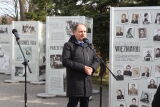back...Opening of the open-air exhibition entitled "Only work and hunger" in Dzierżązna
"I lived and worked in a hole near the mill. Together with other girls I collected stones, harvested potatoes and worked in the house of the owner of the Fuge estate. For minor offenses we were punished in such a way that we were sent to dig up tree stumps, were not given supper, were locked in the cellar..." recalled Danuta Kęsik, a former inmate of the Dzierżązna sub-camp. This is one of the quotes you will be able to read on the board of the Museum's new open-air exhibition entitled "Only work and hunger. The history of a branch of the German concentration camp for Polish children." The opening of the exhibition took place on March 17 this year in the manor park in Dzierżązna.
The latest exhibition of the Muzeum Dzieci Polskich – ofiar totalitaryzmu [eng. Museum of Polish Children – Victims of Totalitarianism] tells the story of the agricultural branch of the German concentration camp for Polish children.
“The sub-camp, bearing the German name Polen-Jugendverwahrlager Litzmannstadt Arbeitsbetrieb "Dzierzazna" über Biala, began operating in the second half of March 1943. The unveiling of the exhibition is part of the commemoration of the girls imprisoned in the branch in connection with the 80th anniversary of this death camp”, explains Dr. Ireneusz Piotr Maj, Director of the Muzeum Dzieci Polskich – ofiar totalitaryzmu [eng. Museum of Polish Children – Victims of Totalitarianism.]
The exhibition is divided into thematic sections on: The history of the establishment of the main camp on Przemysłowa Street in Łódź and its branch in the village of Dzierżązna near Zgierz, the management of the branch and its staff, the camp regime, the living conditions in the branch, as well as the forced labor of the young prisoners sent to Dzierżązna.
- The individual fates of several of the girls incarcerated at the sub-camp occupy a special place in the exhibition.The exhibition concludes with panels dedicated to local forms of remembrance of former female prisoners of the sub-camp. For the most part, the exhibition uses materials collected by local guardians of memory. They have undergone special digital processing, which has made it possible to bring out even the smallest details from the often faded historical photographs," explains Dr. Andrzej Janicki, Museum historian and co-creator of the exhibition.
The official opening of the exhibition took place in the manor park, where the Dzierżązna Branch of the Museum is located.
After the ceremonial opening of the open-air exhibition and the laying of flowers at the memorial plaque, event participants listened to a concert performed by young artists from the Stanislaw Moniuszko Music School Complex in Łódź. This was followed by a screening of the Museum's latest documentary film entitled "It doesn't end there...The story of children from the camp on Przemysłowa Street."

